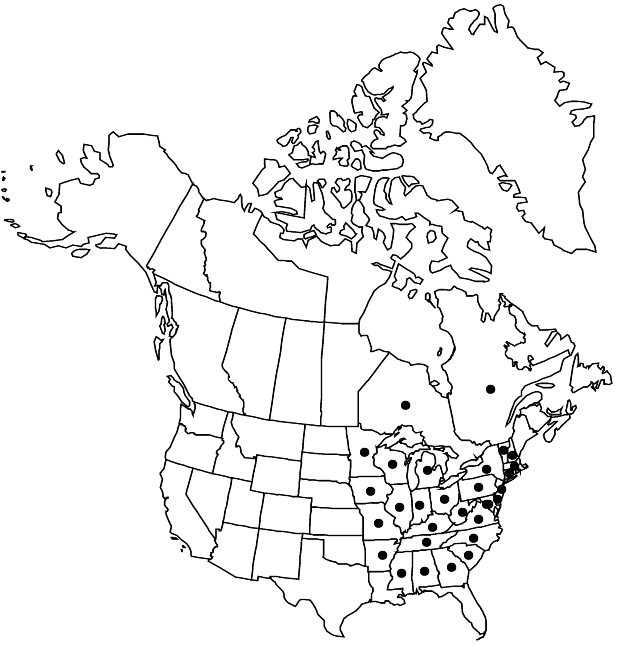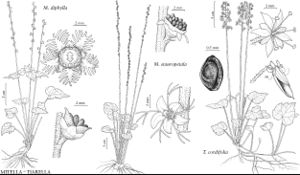Difference between revisions of "Mitella diphylla"
Sp. Pl. 1: 406. 1753 ,.
FNA>Volume Importer |
FNA>Volume Importer |
||
| Line 33: | Line 33: | ||
-->{{#Taxon: | -->{{#Taxon: | ||
name=Mitella diphylla | name=Mitella diphylla | ||
| − | |||
|authority=Linnaeus | |authority=Linnaeus | ||
|rank=species | |rank=species | ||
| Line 48: | Line 47: | ||
|publication year= | |publication year= | ||
|special status= | |special status= | ||
| − | |source xml=https://jpend@bitbucket.org/aafc-mbb/fna-data-curation.git/src/ | + | |source xml=https://jpend@bitbucket.org/aafc-mbb/fna-data-curation.git/src/f50eec43f223ca0e34566be0b046453a0960e173/coarse_grained_fna_xml/V8/V8_217.xml |
|genus=Mitella | |genus=Mitella | ||
|species=Mitella diphylla | |species=Mitella diphylla | ||
Revision as of 23:26, 16 December 2019
Plants not stoloniferous. Flowering stems 10–45(–51) cm. Leaves: petiole 1.8–18 cm, medium and long stipitate-glandular, longer hairs retrorse, white or tan; blade ovate to broadly ovate, ± as long as or longer than wide, 1.4–8.5 × 1.4–9.6 cm, margins shallowly to prominently 3- or 5-lobed, crenate or dentate, irregularly to regularly ciliate, apex of terminal lobe acute, rarely obtuse, surfaces subglabrous or sparsely short and long stipitate-glandular; cauline leaves 2, mid cauline or distal, opposite or subopposite, subsessile to short-petiolate, blade (1.1–)1.6–8 × 0.7–6.5 cm. Inflorescences 1–5, remotely or closely 5–22(–27)-flowered, 1 flower per node, not secund, 10–45(–51) cm, sparsely to densely spreading or retrorsely long stipitate-glandular proximally, short stipitate-glandular distally. Pedicels 1–3 mm, short stipitate-glandular. Flowers: hypanthium broadly campanulate, 1–1.6 × 2–3.4 mm; sepals spreading, greenish white or yellowish green, triangular, 1–1.3 × 0.8–1.1 mm; petals white, 9–11(–15)-lobed, 2–4 mm, lobes linear, lateral lobes spreading or ascending; stamens 10, opposite and alternate with sepals; filaments white, 0.2–0.3 mm; anthers 0.1–0.3 × 0.1–0.2 mm; ovary nearly superior; styles divergent, flattened, 0.1–0.2 mm; stigmas unlobed. Seeds dark reddish brown or blackish, 1.2–1.6 mm, nearly smooth. 2n = 14.
Phenology: Flowering Apr–Jun.
Habitat: Rich woods, hardwoods on ravine slopes
Elevation: 300-2000 m
Distribution

Ont., Que., Ala., Ark., Conn., Del., D.C., Ga., Ill., Ind., Iowa, Ky., Md., Mass., Mich., Minn., Miss., Mo., N.H., N.J., N.Y., N.C., Ohio, Pa., S.C., Tenn., Vt., Va., W.Va., Wis.
Discussion
A decoction from whole plants of Mitella diphylla was used by the Iroquois as an emetic, eye medicine, and good-luck charm; seeds were used by the Menominee as sacred items in medicine dances (D. E. Moerman 1998).
Mitella intermedia T. A. Bruhin ex Small & Rydberg is a presumed interspecific hybrid between M. diphylla and M. nuda. It has been reported from New York and Wisconsin.
Selected References
None.
